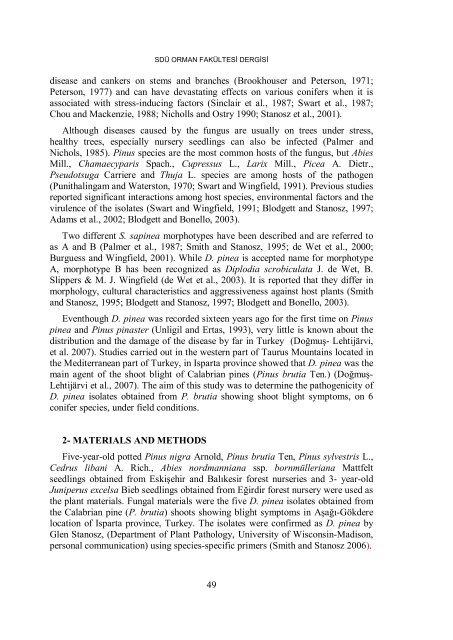sdu faculty of forestry journal special edition 2009 - Orman Fakültesi
sdu faculty of forestry journal special edition 2009 - Orman Fakültesi
sdu faculty of forestry journal special edition 2009 - Orman Fakültesi
Create successful ePaper yourself
Turn your PDF publications into a flip-book with our unique Google optimized e-Paper software.
SDÜ ORMAN FAKÜLTESİ DERGİSİ<br />
disease and cankers on stems and branches (Brookhouser and Peterson, 1971;<br />
Peterson, 1977) and can have devastating effects on various conifers when it is<br />
associated with stress-inducing factors (Sinclair et al., 1987; Swart et al., 1987;<br />
Chou and Mackenzie, 1988; Nicholls and Ostry 1990; Stanosz et al., 2001).<br />
Although diseases caused by the fungus are usually on trees under stress,<br />
healthy trees, e<strong>special</strong>ly nursery seedlings can also be infected (Palmer and<br />
Nichols, 1985). Pinus species are the most common hosts <strong>of</strong> the fungus, but Abies<br />
Mill., Chamaecyparis Spach., Cupressus L., Larix Mill., Picea A. Dietr.,<br />
Pseudotsuga Carriere and Thuja L. species are among hosts <strong>of</strong> the pathogen<br />
(Punithalingam and Waterston, 1970; Swart and Wingfield, 1991). Previous studies<br />
reported significant interactions among host species, environmental factors and the<br />
virulence <strong>of</strong> the isolates (Swart and Wingfield, 1991; Blodgett and Stanosz, 1997;<br />
Adams et al., 2002; Blodgett and Bonello, 2003).<br />
Two different S. sapinea morphotypes have been described and are referred to<br />
as A and B (Palmer et al., 1987; Smith and Stanosz, 1995; de Wet et al., 2000;<br />
Burguess and Wingfield, 2001). While D. pinea is accepted name for morphotype<br />
A, morphotype B has been recognized as Diplodia scrobiculata J. de Wet, B.<br />
Slippers & M. J. Wingfield (de Wet et al., 2003). It is reported that they differ in<br />
morphology, cultural characteristics and aggressiveness against host plants (Smith<br />
and Stanosz, 1995; Blodgett and Stanosz, 1997; Blodgett and Bonello, 2003).<br />
Eventhough D. pinea was recorded sixteen years ago for the first time on Pinus<br />
pinea and Pinus pinaster (Unligil and Ertas, 1993), very little is known about the<br />
distribution and the damage <strong>of</strong> the disease by far in Turkey (Doğmuş- Lehtijärvi,<br />
et al. 2007). Studies carried out in the western part <strong>of</strong> Taurus Mountains located in<br />
the Mediterranean part <strong>of</strong> Turkey, in Isparta province showed that D. pinea was the<br />
main agent <strong>of</strong> the shoot blight <strong>of</strong> Calabrian pines (Pinus brutia Ten.) (Doğmuş-<br />
Lehtijärvi et al., 2007). The aim <strong>of</strong> this study was to determine the pathogenicity <strong>of</strong><br />
D. pinea isolates obtained from P. brutia showing shoot blight symptoms, on 6<br />
conifer species, under field conditions.<br />
2- MATERIALS AND METHODS<br />
Five-year-old potted Pinus nigra Arnold, Pinus brutia Ten, Pinus sylvestris L.,<br />
Cedrus libani A. Rich., Abies nordmanniana ssp. bornmülleriana Mattfelt<br />
seedlings obtained from Eskişehir and Balıkesir forest nurseries and 3- year-old<br />
Juniperus excelsa Bieb seedlings obtained from Eğirdir forest nursery were used as<br />
the plant materials. Fungal materials were the five D. pinea isolates obtained from<br />
the Calabrian pine (P. brutia) shoots showing blight symptoms in Aşağı-Gökdere<br />
location <strong>of</strong> Isparta province, Turkey. The isolates were confirmed as D. pinea by<br />
Glen Stanosz, (Department <strong>of</strong> Plant Pathology, University <strong>of</strong> Wisconsin-Madison,<br />
personal communication) using species-specific primers (Smith and Stanosz 2006).<br />
49








